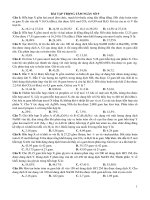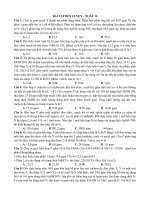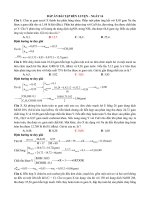- Trang chủ >>
- Đề thi >>
- THPT Quốc Gia
BÀI tập NGÀY 21 7(KEYS)
Bạn đang xem bản rút gọn của tài liệu. Xem và tải ngay bản đầy đủ của tài liệu tại đây (274.5 KB, 9 trang )
KHÓA NGỮ PHÁP TỐI THỨ 5
(Dành cho các bạn 2k1,2k2,2k3)
BÀI TẬP NGÀY 2190/7/2018
Compiled by Mrs Trang Anh
Facebook: Mrstranganh87
Question 1: They would ______ go by air than spend a week travelling by train.
A. always
B. rather
C. prefer
D. better
Đáp án B
Kiến thức: Các cấu trúc đi với “would”
Giải thích:
would rather do sth than do sth: thà làm cái gì cịn hơn làm cái gì
would prefer to do sth rather than do sth: thích làm cái gì hơn cái gì
Tạm dịch: Họ thà đi bằng máy bay còn hơn là dành cả một tuần ngồi tàu.
Question 2: “Shall I help you do the dishes, Carlo?” said Robert.
A. Robert suggested helping Carlo with the dishes.
B. Robert suggested to help Carlo do the dishes.
C. Robert offered Carlo to help do the dishes.
D. Robert offered to help Carlo do the dishes.
Đáp án D
Kiến thức: Viết lại câu
Giải thích:
Tạm dịch: "Tơi sẽ giúp bạn làm các món ăn nhé Carlo? " Robert nói.
A. Robert gợi ý giúp Carlo với các món ăn.
B. Sai cấu trúc với suggest.
C. Sai cấu trúc với offer, thường ta dùng offer + sb + sth
D. Robert đề nghị giúp Carlo làm các món ăn.
Question 3: John and Karen persuaded me ….. the conference.
A. attending
Đáp án C
Kiến thức: Động từ
B. attended
C. to attend
D. to have attended
Giải thích:
Persuade + smb + to V: thuyết phục ai làm gì
Question 4: I think it’s ….. to take a few more pictures.
A. enough light
B. lightly enough
C. light enough
D. enough as light
Đáp án C
Kiến thức: Cấu trúc câu
Giải thích:
…tính từ + enough + ( for smb) + to V…: đủ thế nào ( cho ai ) đó để làm gì…
… enough + danh từ + (for smb) + to V: đủ cái gì ( cho ai ) để làm gì …
Tạm dịch: Tôi nghĩ đủ sáng để chụp thêm vài bức ảnh.
Question 5: ….I heard the phone ring, I didn’t answer it.
A. because
B. Only if
C. Even though
D. Provided that
Đáp án C
Kiến thức: Từ vựng
Giải thích:
Because: bởi vì
Only if: chỉ nếu
Even though: mặc dù
Provided that: miễn là
Tạm dịch: Mặc dù tôi nghe thấy tiếng chuông điện thoại reo nhưng tôi không trả lời.
Question 6: The soccer team knew they lost the match. They soon started to blame each other.
A. Not only did the soccer team lose the match but they blamed each other as well
B. No sooner had the soccer team started to blame each other than they knew they lost the match.
C. As soon as they blamed each other, the soccer team knew they lost the match.
D. Hardly had the soccer team known they lost the match when they started to blame each other.
Đáp án D
Kiến thức: Nối câu
Giải thích: Đội bóng đá biết rằng họ đã thua. Họ sớm bắt đầu đổ lỗi cho nhau.
A. Khơng những đội bóng đá thua trận đấu mà họ còn đổ lỗi lẫn nhau.
B. Ngay khi đội bóng bắt đầu đổ lỗi cho nhau thì họ thua.
C. Ngay sau khi đổ lỗi cho nhau, đội bóng đá biết rằng họ đã thua.
D. Ngay khi đội bóng biết rằng đã thua thì họ bắt đầu đổ lỗi cho nhau.
Question 7: “ Why don’t you get your hair cut, Gavin?” said Adam.
A. Adam advised Gavin to cut his hair.
B. Gavin was suggested to have a hair cut.
C. It was suggested that Adam get Gavin’s haircut.
D. Adam suggested that Gavin should have his hair cut.
Đáp án D
Kiến thức: Câu đồng nghĩa
Giải thích:
"Tại sao cậu khơng cắt tóc Gavin nhỉ?" Adam nói.
A. Adam khuyên Gavin cắt tóc.
B. Gavin đã được gợi ý để cắt tóc.
C. Có thể cho rằng Adam đã cắt tóc của Gavin.
D. Adam gợi ý rằng Gavin nên cắt tóc.
Question 8: Hans told us about his investing in the company. He did it on his arrival at the
meeting.
A. Only after investing in the company did Hans inform us of his arrival at the meeting.
B. Not until Hans told us that he would invest in the company did he arrive at the meeting.
C. Hardly had he informed us about his investing in the company when Hans arrived at the
meeting.
D. No sooner had Hans arrived at the meeting than he told us about his investing in the company.
Đáp án D
Kiến thức: Đảo ngữ với Hardly…when… và No sooner…than…
Giải thích:
Cấu trúc đảo ngữ với Hardly…when… và No sooner…than…
Hardly/No sooner + had + S + PP +… + when/than + mệnh đề bình thường
Khi dùng cấu trúc này, ta diễn tả hành động ở vế thứ 2 xảy ra ngay sau vế thứ nhất.
Tạm dịch: Hans vừa đến cuộc họp thì anh ấy đã thơng báo cho chúng tơi về việc đầu tư của anh
ấy trong công ty.
Question 9: ______ humans, dolphins use a system of sounds and body language to
communicate, but understanding their conversations is not easy for humans.
A. Alike
B. Unlike
C. Dislike
D. Like
Đáp án D
Kiến thức: Từ vựng, đọc hiểu
Giải thích:
alike (a): giống, giống nhau
dislike (v): khơng thích, ghét
unlike (giới từ, tính từ): khơng giống, khác
like (giới từ, tính từ): giống, giống như
Tạm dịch: Giống như con người, cá heo sử dụng hệ thống âm thanh và ngôn ngữ cơ thể để giao
tiếp, nhưng hiểu được cuộc trò chuyện của chúng không dễ dàng đối với con người.
Question 10: The trainers encourage the animals ______, but the elephants make their own
songs; they don’t just copy their trainers or other people.
A. to play
B. play
C. playing
D. that play
Đáp án A
Kiến thức: Phrase, từ vựng
Giải thích:
To encourage sth/sb to do sth: khuyến khích cái gì/ai làm việc gì
Tạm dịch: Các huấn luyện viên khuyến khích động vật chơi, nhưng voi tạo ra bài hát của mình;
chúng khơng chỉ sao chép huấn luyện viên hay những người khác.
Question 11: In order to avoid to make mistakes, take your time and work carefully.
A. In order to
B. to make
C. take
D. carefully
Đáp án B
Kiến thức: Phrase, sửa lại câu
Giải thích:
to make => making
Cấu trúc to avoid doing sth: tránh làm cái gì
Tạm dịch: Để tránh mắc sai lầm, hãy từ từ và làm việc cẩn thận.
Question 12: Who was the first person ______ the South Pole?
A. who reaches
B. reaching
C. to reach
D. reached
Đáp án C
Kiến thức: Cấu trúc “the first/second/last... + N + to do sth”
Giải thích:
Cấu trúc “the first/second/last... + N + to do sth”: N đầu tiên/thứ 2/cuối cùng… làm việc gì
Tạm dịch: Ai là người đầu tiên đến Nam Cực?
Question 13: Thank you very much. I haven’t been to_______party for ages.
A. so enjoyable
B. the so enjoyable
C. so enjoyable a
D. a so enjoyable
Đáp án C
Kiến thức: Cấu trúc nhấn mạnh với so
Giải thích:
Đối với danh từ đếm được số ít, chúng ta có cấu trúc sau:
S + V + so + adj + a + noun (đếm được số ít) +…
Tạm dịch: Cảm ơn rất nhiều. Tôi đã không đến một bữa tiệc thú vị như vậy rất lâu rồi.
Question 14: The Alaskan malamute, used extensively for pulling sleds, is closely related about
the wolf.
A. used
B. for pulling
C. closely
D. about
Đáp án D
Kiến thức: Giới từ, sửa lại câu
Giải thích:
about => to
Cấu trúc to be related to: có quan hệ với, liên quan tới
Tạm dịch: Chó Alaska, được sử dụng rộng rãi để kéo xe trượt tuyết, có liên quan chặt chẽ với
sói.
Question 15: We couldn’t have managed our business successfully without my father’s money.
A. Had it not been for my father’s money, we couldn’t have managed our business successfully.
B. We could have managed our business successfully with my father’s money.
C. If we could manage our business successfully, my father would give us his money.
D. If we couldn’t have managed our business successfully, we would have had my father’s
money.
Đáp án A
Kiến thức: Câu điều kiện, viết lại câu
Giải thích:
Tạm dịch: Chúng tôi đã không thể quản lý thành công doanh nghiệp nếu khơng có tiền của bố
tơi.
A. Nếu khơng có tiền của bố tôi, chúng tôi đã không thể quản lý thành cơng doanh nghiệp của
chúng tơi.
B. Chúng tơi đã có thể quản lý thành công doanh nghiệp với tiền của bố tơi.
C. Nếu chúng tơi có thể quản lý thành công doanh nghiệp, bố tôi sẽ cho chúng tôi tiền.
D. Nếu chúng tôi đã không thể quản lý doanh nghiệp thành cơng, chúng tơi sẽ có tiền của bố tơi.
Question 16: She doesn’t want to go to their party. We don’t want to go either.
A. Either we or she don’t want to go to their party.
B. Neither we nor she want to go to their party.
C. Neither we nor she wants to go to their party.
D. Neither she nor we don’t want to go to their party.
Đáp án C
Kiến thức: Cấu trúc với either và neither
Giải thích:
Trong câu có neither thì khơng chia phủ định nữa => đáp án D loại
“Neither S1 nor S2” thì động từ được chia theo S2 => đáp án A,B loại
Tạm dịch:
Cô ấy không muốn đi dự tiệc của họ. Chúng tôi cũng không muốn đi.
=> Cả chúng tôi lẫn cô ấy đều không muốn đi đến bữa tiệc của họ.
Question 18: The progress made in spacetravel for the early 1960s is remarkable.
A. progress
B. made
C. in space
D. for
Đáp án D
Kiến thức: Giới từ
Giải thích:
In the early 1960s: vào đầu những năm 1960.
For => in
Tạm dịch: Tiến bộ trong chuyến du hành không gian vào đầu những năm 1960 là đáng chú ý.
Question 19. ________, we tried our best to complete it.
A. Difficult as the homework was
B. As though the homework was difficult
C. Thanks to the difficult homework
D. Despite the homework was difficult
Kiến thức: mệnh đề nhượng bộ
Giải thích:
Cấu trúc: Adj + as + S + V, clause (S + V + O…)
Thanks to + N: nhờ có
Despite + N: mặc dù
As if/ As though: như thể là
Tạm dịch: Mặc dù bài tập về nhà rất khó nhưng chúng tơi đã cố gắng hết sức mình để hồn thành.
Question 20. They always kept on good _______ with their next-door neighbors for the
children’s sake.
A. relations
B. terms
C. will
D. relationship
Question 30
Kiến thức: từ vựng
Giải thích:
relations: khi được dùng như số nhiều sẽ ám chỉ cách xử xự và liên hệ giữa hai nhóm người hoặc
chủ thể lớn hơn như là giữa các quốc gia với nhau
terms: điều kiện
will: khả năng kiểm soát suy nghỉ và hành động
relationship: đề cập đến một mối quan hệ, cách mà mọi người cảm thấy và đối xử với nhau
Tạm dịch: Họ ln giữ mối quan hệ tốt với hàng xóm bên cạnh của họ vì lợi ích của trẻ em.
Question 21: She didn’t understand the benefits of volunteering until she joined this club.
A. Not until she joined this club did she understand the benefits of volunteering.
B. It was not until she joined this club did she understand the benefits of volunteering.
C. Not until did she join this club, she understood the benefits of volunteering.
D. Not until she joined this club that she understood the benefits of volunteering.
Đáp án A
Kiến thức: cấu trúc câu
Giải thích:
It is/ was not until + clause/ adv of time + that... + S + V = Not until + clause/ adv of time +
Auxiliary + S + V
=> nhấn mạnh khoảng thời gian mà một sự việc xảy ra.
Thông tin: Cho đến khi cô tham gia câu lạc bộ này, cơ mới hiểu được những lợi ích của hoạt
động tình nguyện.
Question 22: He didn’t prepare well for his GCSE examination and he regrets it now.
A. Unless he had prepared well for his GCSE examination, he wouldn’t regret it now.
B. But for his ill preparation for his GCSE examination, he wouldn’t regret it now.
C. If it hadn’t been for his good preparation for his GCSE examination, he wouldn’t regret it now.
D. If he had prepared well for his GCSE examination, he wouldn’t have regretted it now.
Đáp án B
Kiến thức: câu điều kiện loại hỗn hợp
Giải thích:
Câu điều kiện loại hỗn hợp diễn tả giả thiết trái ngược với quá khứ, nhưng kết quả thì trái ngược
với hiện tại.
Cấu trúc: If + S + had + V.p.p, S + would + V.inf
If + S + had + V.p.p = But for + N = If it hadn’t been for + N
Unless = If not (chỉ dùng trong câu điều kiện loại 1)
Tạm dịch: Nếu chuẩn bị tốt cho kỳ thi GCSE thì giờ anh ấy đã khơng hối hận.
Question 23: People believe that Chinese people invented paper.
A. Paper is believed to have been invented by Chinese people.
B. Paper is believed to be invented by Chinese people.
C. It was believed that Chinese people invent paper.
D. Chinese people are believed to invent paper.
Đáp án A
Kiến thức: cấu trúc câu
Giải thích:
Active: People/ They + think/ say/ suppose/ believe/ consider/ report ... + THAT + clause
(simple present/ simple past or present perfect)
Passive 1: IT + tobe + thought/ said/ supposed/ believed/ considered/ reported ... + THAT + clause
Passive 2: S + tobe + thought/ said/ supposed/ ... + To Vinf (simple present) / To have V.p.p
(simple past or present perfect)
Thông tin: Giấy được cho là đã được người Trung Quốc phát minh ra.
Question 24: On hearing that she failed the entrance exam, Trang couldn’t help ____ into tears.
A. bursting
B. burst
C. to bursting
D. to burst
Đáp án A
Kiến thức: cấu trúc can’t/ couldn’t help
Giải thích:
can’t/ couldn’t help + V.ing: khơng nhịn được/ khơng thể khơng…
Tạm dịch: Khi nghe rằng mình đã trượt kỳ thi đại học, Trang khơng nhịn được ịa khóc.
Mark the letter A, B, C, or D on your answer sheet to indicate the word whose underlined part
is pronounced differently from that of the rest in each of the following questions
Question 1:
A. exhibition
B. childhood
C. holiday
D. hilarious
Question 2:
A. tough
B. rough
C. enough
D. through
Question 3:
A. looked
B. laughed
C. decided
D. experienced
Question 4:
A. break
B. increase
C. speak
D. cheat
Question 5:
A. suggestion
B. solution
C. information
D. education
Question 6:
A. involved
B. maintained
C. laughed
D. formed
Question 7:
A. Whistle
B. little
C. gentle
D. battle
Question 8:
A. Wicked
B. Sacred
C. Beloved
D. Helped
Question 9:
A. Empty
B. Deny
C. Sleepy
D. Hurry
Question 10:
A. Scholar
B. Character
C. Charity
D. Chemist
Question 11:
A. weighed
B. toughed
C. laughed
D. coughed
Question 12:
A. choir
B. soil
C. noise
D. choice
Mark the letter A, B, C, or D on your answer sheet to indicate the word that differs from the
rest in the position of the main stress in each of the following questions.
Question 1:
A. gorilla
B. panda
C. parrot
D. leopard
Question 2:
A. considerate
B. photographer
C. community
D. residential
Question 3:
A. permanent
B. continue
C. complete
D. relationship
Question 4:
A. endanger
B. geometry
C. opposite
D. geography
Question 5:
A. industry
B. sacrifice
C. ancestor
D. determine
Question 6:
A. available
B. kindergarten
C. attractiveness
D. contractual
Question 7:
A. Integral
B. Terrific
C. Museum
D. Cathedral
Question 8:
A. Architectural
B. cosmopolitan
C. appreciative
D. archeologist
Question 9:
A. History
B. Musician
C. Computer
D. Conclusion









